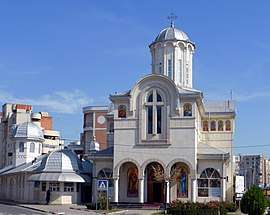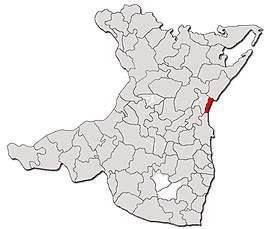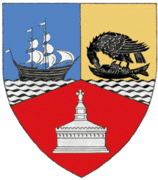Năvodari
Năvodari (Romanian pronunciation: [nəvoˈdarʲ], historical names: Carachioi; Caracoium, Turkish: Kara Koyum) is a town in Constanța County, region of Northern Dobruja, Romania, with a population of 32,400. The town formally includes a territorially distinct community, Social Group Peninsula, and administers the neighbouring village of Mamaia-Sat.
Năvodari | |
|---|---|
 Annunciation Church | |
 Coat of arms | |
 Location in Constanța County | |
 Năvodari Location in Romania | |
| Coordinates: 44°19′16″N 28°36′48″E | |
| Country | |
| County | Constanța |
| Subdivisions | Mamaia-Sat |
| Government | |
| • Mayor | Florin Chelaru[1] (PSD) |
| Area | 70.31 km2 (27.15 sq mi) |
| Population (2011)[2] | 32,981 |
| • Density | 470/km2 (1,200/sq mi) |
| Time zone | EET/EEST (UTC+2/+3) |
| Vehicle reg. | CT |
| Website | http://www.primaria-navodari.ro/ |
History
The settlement was mentioned for the first time in 1421 under the name Kara Koyun ("Black Sheep"), to be renamed later on Karaköy or Carachioi ("The Black Village"). In 1927, the locality was again renamed to Năvodari and after five years, on 15 August 1932, it was granted commune status.
The town developed during the communist regime as part of the industrialization program. In 1957, the superphosphate and sulfuric acid plant, also known as USAS (Uzina de Superfosfat si Acid Sulfuric, Superphosphate and Sulfuric Acid Factory), whose construction had started in 1954, was opened, paving the road towards the industrialization of the area and demographic growth. However, the factory polluted the Black Sea and Taşaul Lake with toxic dumps. In the 1990s, the pollution was greatly reduced as the factory was modernized.
In 1968 the population of Năvodari exceeded 6,500 inhabitants. A law adopted that year granted the commune of Năvodari town status and placed the Mamaia Sat village under its administration.
The modernization of the town began in 1975 and finished on 29 June 1979.
Current status
Today Năvodari is an important chemical and industrial town containing a car repairs factory and a Petromidia factory specialized in petrochemical products.
Năvodari has also developed in the social and cultural fields; in the city center there is a children's town, built between 1969 and 1972, vacation accommodations, and sports facilities where up to 12,000 visitors can be accommodated.
Some 5 kilometres from the town itself there is a summer camp (the largest one in Romania), built under the communist regime for school children. Due to its interesting programmes, good accommodation and affordable prices, it was extremely popular among teachers and parents. In the early 2000s, it was opened for the public at large as a cheap seaside resort.
Demographics
| Historical population | ||
|---|---|---|
| Year | Pop. | ±% |
| 1977 | 9,717 | — |
| 1992 | 31,746 | +226.7% |
| 2002 | 32,400 | +2.1% |
| 2011 | 31,554 | −2.6% |
| Source: Census data | ||
At the 2011 census, Năvodari had 29,873 Romanians (94.67%), 283 Hungarians (0.90%), 309 Roma (0.98%), 10 Germans (0.03%), 297 Turks (0.94%), 115 Tatars (0.36%), 545 Lipovans (1.73%), 27 Aromanians (0.09%), 77 others (0.24%), 18 with undeclared ethnicity (0.06%) .
Gallery
Notable natives
- Adrian Lungu, Romania's most capped rugby union player, was born in Năvodari.
- Laurențiu Duță, member of the 3rei Sud Est band
References
| Wikimedia Commons has media related to Năvodari. |
- "Luptă strânsă pentru Consiliul Judeţean Constanţa între PSD şi PNL. Noua garnitură de primari" (in Romanian). Ziua de Constanța. 7 June 2016.
- "Populaţia stabilă pe judeţe, municipii, oraşe şi localităti componenete la RPL_2011" (in Romanian). National Institute of Statistics. Retrieved 4 February 2014.
